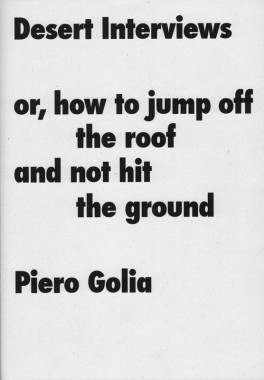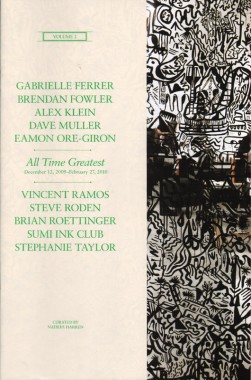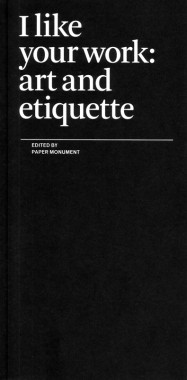Desert Interviews or, how to jump off the roof and not hit the ground
Piero Golia, Desert Interviews or, how to jump off the roof and not hit the ground
Softcover, 100 pp., offset 4/1, 148 x 210 mm
Edition of 2000
ISBN 978-3-03764-106-4
Published by JRP|Ringier
$28.00 ·
This book, composed of discussions between artists, presents a kind of report on this unique “institution:” teaching methods, academic syllabus, and students’ selection are here explained with metaphors, compared with artistic interaction, and equaled to performances. Not unlike Golia’s work itself, the development of the school and its program follow a poetic of the gesture, of the instant, and of actions recalling Fluxus, Gino de Dominicis’ or Paul McCarthy’s works.
As a career’s start, Piero Golia successfully convinced a woman to have his portrait and the words “Piero My Idol” tattooed on her back (tattoo, 2001); soon after, following an invitation to the Tirana Biennale, he rowed across the Adriatic Sea in the opposite direction to migratory movement to reach Albania (”Going to Tirana,” 2000). And, on January 14, 2005, Golia vanished from New York City leaving no documented proof of his whereabouts; he traveled from a place to another, crossing borders without a trace, for resurfacing only on the morning of February 7 at the Royal Academy of Arts in Copenhagen for a unique lecture about his adventurous trip. He now lives in Los Angeles, a place that blurs the boundaries between reality and fiction, making it the perfect setting for his exploration into the process of myth-making and his ironic outlook on contemporary society.
All Time Greatest
Natilee Harren and Andrew Berardini, All Time Greatest
Softcover, 32 pp., mimeograph 1/1 + offset 4/4, 190 x 280 mm
Edition of 150
Vol. 1 (texts) + Vol. 2 (images)
Published by Fellows of Contemporary Art
$10.00 ·
Beyond the emergent field of sound art, there exist certain artists for whom music forms one aspect of a multi-faceted practice or for whom it plays a deep influence that may not find expression outside the studio. Conceived as a concept album-turned-exhibition, All Time Greatest offers the opportunity to consider how artists’ musical predilections — the secret soundtrack to their production — might add a dimension of significance to their work in an exhibition setting. The exhibition features the work of 11 LA-based artists: Gabrielle Ferrer, Brendan Fowler, Alex Klein, Dave Muller, Eamon Ore-Giron, Vincent Ramos, Steve Roden, Brian Roettinger, Sumi Ink Club (Luke Fischbeck and Sarah Rara), and Stephanie Taylor.
With the curator repositioned as fan or enthusiast, artists were selected out of an admiration for or curiosity about their musical knowledge and tastes. The center of the gallery will feature a turntable and record collection composed of each artist’s chosen “all time greatest” album. Visitors are welcome to thumb through and listen to the records. The pairing of visual art and music emphasizes the temporal dimension of viewing, and comfortable seating will invite visitors to spend extended time with the works on display. Against the culture of rapid digital file sharing, All Time Greatest uses the exhibition format as an opportunity to revive an analog, old-school approach to sharing music at the same time that it adapts the fan culture of audiophiles to the task of the curator.
I like your work: art and etiquette
Paper Monument, I like your work: art and etiquette
Softcover, 56 pp., offset 1/1, 4.25 x 8.5 inches
Second edition
ISBN 978-0-9797575-2-5
Published by Paper Monument
$8.00 · out of stock
The art world is now both socially professional and professionally social. Curators visit artists’ studios; collectors, dealers, and journalists assemble for a reception and reconvene later for dinner; everyone goes to parties. We exchange introductions and small talk; art is bought and sold; careers (and friendships) brighten or fade. In each situation, certain behaviors are expected while others are silently discouraged. Sometimes, what’s appropriate in the real world would be catastrophic in the art world, and vice versa.
Making these distinctions on the spot can be nerve-wracking and disastrous. So we asked ourselves: What is the place of etiquette in art? How do social mores establish our communities, mediate our critical discussions, and frame our experience of art? If we were to transcribe these unspoken laws, what would they look like? What happens when the rules are broken? Since we didn’t have all the answers, we politely asked our friends for some help.
I like your work: art and etiquette
Paper Monument, I like your work: art and etiquette
Softcover, 56 pp., offset 1/1, 4.25 x 8.5 inches
Edition of 500
ISBN 978-0-9797575-2-5
Published by Paper Monument
out of print · order second edition
The art world is now both socially professional and professionally social. Curators visit artists’ studios; collectors, dealers, and journalists assemble for a reception and reconvene later for dinner; everyone goes to parties. We exchange introductions and small talk; art is bought and sold; careers (and friendships) brighten or fade. In each situation, certain behaviors are expected while others are silently discouraged. Sometimes, what’s appropriate in the real world would be catastrophic in the art world, and vice versa.
Making these distinctions on the spot can be nerve-wracking and disastrous. So we asked ourselves: What is the place of etiquette in art? How do social mores establish our communities, mediate our critical discussions, and frame our experience of art? If we were to transcribe these unspoken laws, what would they look like? What happens when the rules are broken? Since we didn’t have all the answers, we politely asked our friends for some help.
fillip 7
fillip 7
Softcover, 28 pp. + two posters, offset 1/1, 12 x 18 inches
Edition of 1500
Published by Fillip
$5.00 ·
Fillip is a publication of art, culture and ideas released three times a year by the Projectile Publishing Society from Vancouver, British Columbia.


